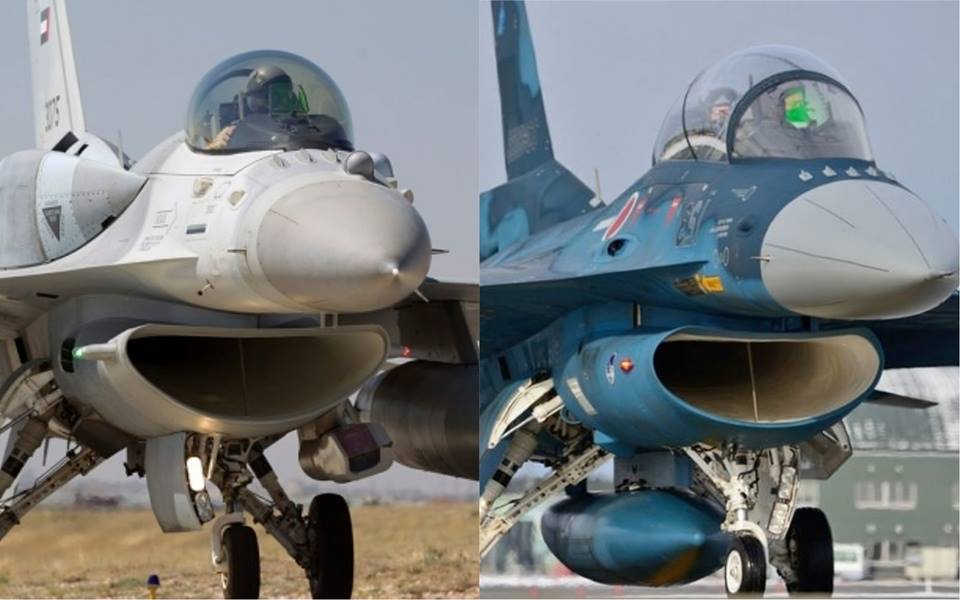F-16 Fighting Falcon vs Mitsubishi F-2 (what’s the difference?)

![]()
The F-2 is a joint project between Lockheed Martin and Mitsubishi, with both American and Japanese manufacturers supplying components.
The F-2 was built about 20 years after the F-16’s initial production runs, it has a considerably larger wing area and is roughly the same weight and more maneuverable, Mitsubishi used composite structures for the framing and spars which allows this to be the case.
It was also designed with an electronically scanned radar well before the F-16 got upgraded. It has a slightly larger payload, more range, and the opportunity for a better radar (the current radars are roughly equal but the potential is there for the F-2 to be better next upgrade it has more space.)
Without losing maneuverability and has a slightly reduced radar return. While the F-2 bears a striking resemblance to the F-16 and is derived from it over 95% of the aircraft is different. The two are very comparable to an F-18 hornet and a F/A 18 super hornet.
It’s largely based on the F-16A but has some notable differences:
Larger wing area and tailplane area for better payload and maneuverability
Heavier weight
Radar-absorbant composite skin
AESA radar
Redesigned cockpit canopy
Support for weapons that the F-16 cannot fire, such as the ASM-1 and ASM-2 anti-ship missiles
Very different avionics, including more display screens
I don’t really answer “which is superior” and “which would win in a dogfight” questions, but suffice it to say, both aircraft have their specific advantages and disadvantages. The F-2 is heavier and less fuel-efficient but carries more and turns better. It has an AESA radar and composite airframe but has not benefited from the avionics upgrades of the F-16 MLU program.
The Mitsubishi F-2 is a multirole fighter derived from the General Dynamics F-16 Fighting Falcon and manufactured by Mitsubishi Heavy Industries and Lockheed Martin for the Japan Air Self-Defense Force, with a 60/40 split in manufacturing between Japan and the United States. Production started in 1996 and the first aircraft entered service in 2000.
The first 76 aircraft entered service in 2008, with a total of 94 airframes produced. The first active electronically scanned array (AESA) radar on a combat aircraft was the J/APG-1 introduced on the Mitsubishi F-2 in 1995.
General Electric, Kawasaki, Honeywell, Raytheon, NEC, Hazeltine, and Kokusai Electric are among the primary component sub-contractors. Lockheed Martin supplies the aft fuselage, leading-edge slats, stores management system, a large portion of wing boxes (as part of two-way technology transfer agreements), and other components.
Kawasaki builds the midsection of the fuselage, as well as the doors to the main wheel and the engine, while the forward fuselage and wings are built by Mitsubishi. Avionics are supplied by Lockheed Martin, and the digital fly-by-wire system has been jointly developed by Japan Aviation Electric and Honeywell (formerly Allied Signal)
General Dynamics F-16 Fighting Falcon
The General Dynamics F-16 Fighting Falcon is a single-engine supersonic multirole fighter aircraft originally developed by General Dynamics (now Lockheed Martin) for the United States Air Force (USAF).
Designed as an air superiority day fighter, it evolved into a successful all-weather multirole aircraft. Over 4,500 aircraft have been built since production was approved in 1976.
The Fighting Falcon’s key features include a frameless bubble canopy for better visibility, a side-mounted control stick to ease control while maneuvering, a seat reclined 30 degrees to reduce the effect of g-forces on the pilot, and the first use of a relaxed static stability/fly-by-wire flight control system which helps to make it a nimble aircraft.
The F-16 has an internal M61 Vulcan cannon and 11 locations for mounting weapons and other mission equipment. The F-16’s official name is “Fighting Falcon”, but “Viper” is commonly used by its pilots and crews, due to a perceived resemblance to a viper snake as well as the Colonial Viper starfighter on Battlestar Galactica





